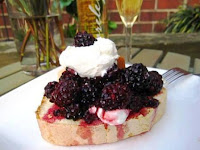For me, the mere mention spring conjures up memories of the old Meyer lemon tree in my parents’ backyard. This still standing, ancient tree is always full of delicious Meyer lemons and is teeming with bees, sparrows and my particular favorite, hummingbirds. When I first sipped this month’s featured wine, a dessert wine, it had me thinking about that old lemon tree.

Dessert wines, those sweet darlings, that most of us love
(and purchase) when we are out tasting at a winery or wine festivals, that when
brought home languish on the wine racks. Languish on the rack you say? Yes, I
am as guilty as many others who purchase dessert wines and never quite sure
when to bring them out. The dilemma: Are they special occasion wines? What to
pair them with? Will everyone like it? etc. and so, often times the wine stays
on the rack. Why, because dessert wines can be a challenge to pair with
food. The main reason for this is dessert wine tend to be potent, full of
flavor and very sweet; often overpowering the desserts, particularly sweet
desserts. One can better appreciate such wine if it is paired with fruits, foie
gras, cheese or not overly sweet cakes. Although there are those that say the
dessert wine is often best appreciated by itself.

Chosen for this tasting is Loreley 2009 ‘Late Harvest’ (50%
Viognier and 50% Petite Manseng) by King Family Vineyard located in Crozet, just
outside Charlottesville, VA. King Family Vineyard was one of the three wineries
that collaborated on the Bordeaux Styled Blend “3” featured in last month’s
article. King Family Vineyard is a Family-owned producer of a range of red,
white, rosé, sparkling and dessert wines. This winery is located in the heart
of the Monticello AVA and was established in 1998.
Pairing: Meyer Lemon
Pound cake with macerated blackberries and lemon whipped cream.
I started with macerating the blackberries and letting them soak in a one-eighth cup of the Loreley wine. The scent of the blackberries intermingled with the citrus and floral scents of the wine nicely. The berries were left to sit in the wine mixture for the better part of the afternoon, while I mixed and baked the lemon pound cake. Once the lemon pound cake cooled, I prepared the lemon whipped cream. Using a microplane I carefully zested the lemon, as I did that the scent of lemon filled the kitchen. After zesting, the lemon was juiced for the whipped cream. After whipping the lemon juice, heavy whipping cream and a dash of powdered sugar the lemon zest was carefully folded in to the whipped cream.
The Loreley wine was served chilled. The color was a golden
yellow with a nose of citrus, notably orange peel, and floral notes. After
swirling the wine, notes of candied fruit emerged. On tasting the wine bright
citrus notes, honey, toast and a touch of spice were detected.
 The wine is balance with a medium density and a nice finish.
The toast notes come from the wine being fermented and aged in new oak barrels.
The wine by itself is a delicious dessert all by it self. When paired with the
dessert the wine was a nice compliment. The pound cake tempered the sweetness
of the Loreley wine which comes in at 10% residual sugar. The lemon enhanced
the bright citrus notes of wine. The wine made the taste of blackberries pop.
The wine is balance with a medium density and a nice finish.
The toast notes come from the wine being fermented and aged in new oak barrels.
The wine by itself is a delicious dessert all by it self. When paired with the
dessert the wine was a nice compliment. The pound cake tempered the sweetness
of the Loreley wine which comes in at 10% residual sugar. The lemon enhanced
the bright citrus notes of wine. The wine made the taste of blackberries pop.
Dessert wine can be a fun and rewarding adventure in wine.
One just had to keep in mind the sweetness factor of both the wine and dessert.
So if you have any bottles of dessert wine languishing on the wine rack, dust
them off and pair them with this Spring’s bountiful offering of fruits and
cheeses or enjoy them on their own. Happy Spring!


